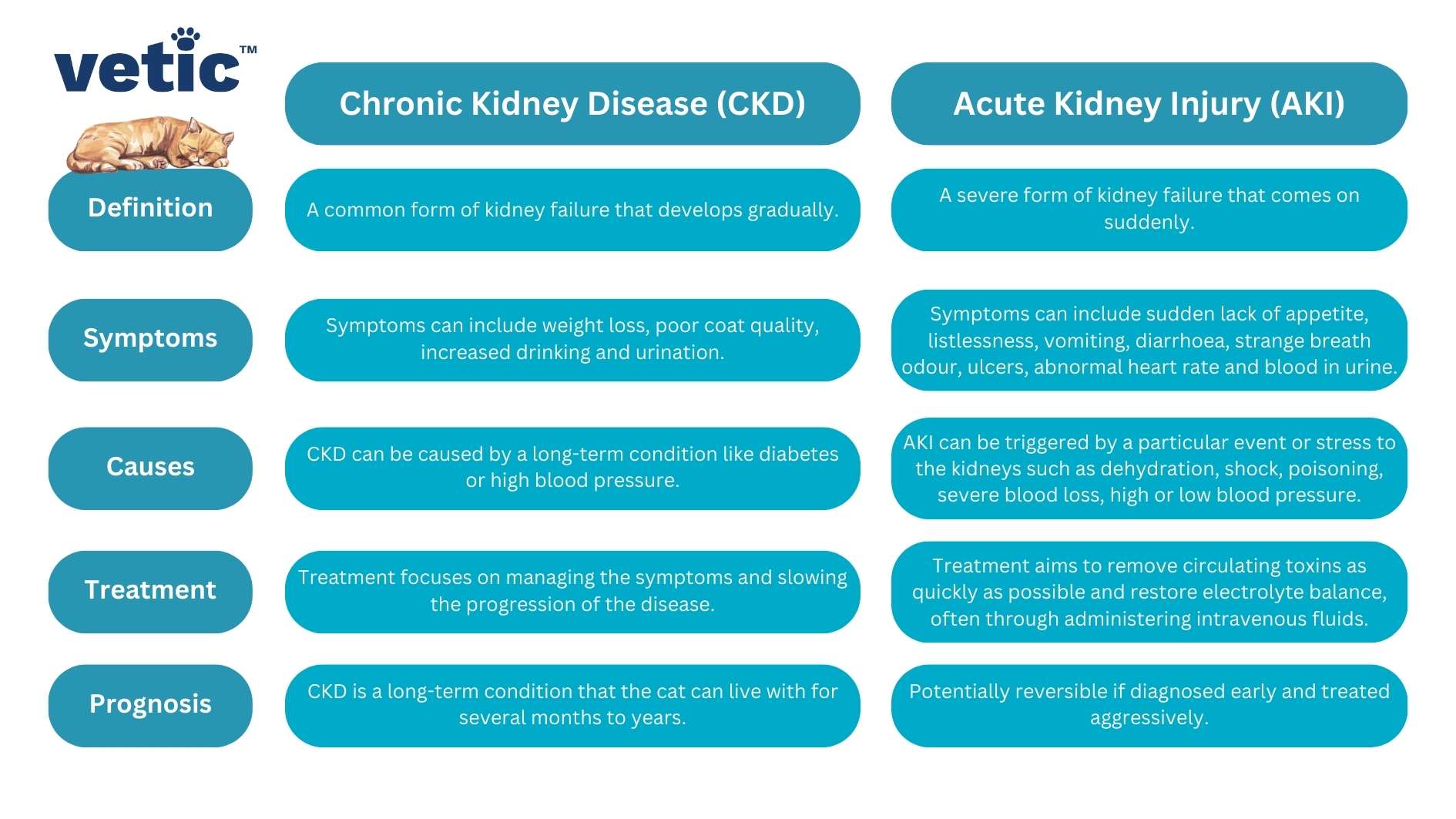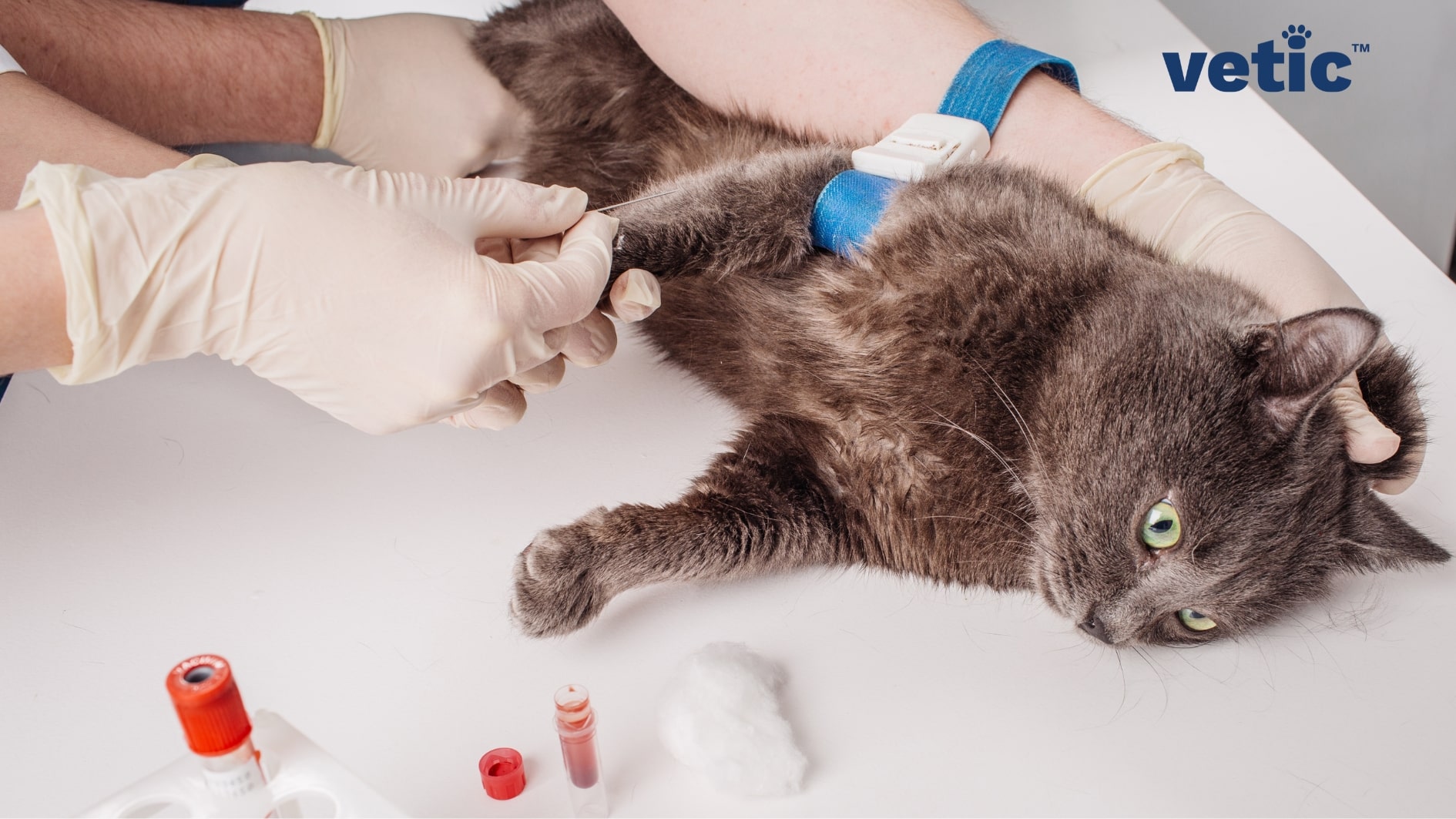Chronic kidney disease in cats or CKD is more of a state than a particular disease. By state, we mean, it indicates the ability of the kidneys to function.
To understand CKD and its consequences, we must first understand what the kidneys do.
Kidneys are filtering organs. They are part of the excretory system and they filter the impurities out of the blood. When functioning properly, the kidneys can concentrate the waste products and send them out of the body through the urine.
However, as their filtering abilities go down, they are unable to filter out waste as efficiently and they cannot concentrate the waste products in the urine. Hence, any cat suffering from chronic kidney disease or CKD often drinks more water and pees more frequently.
If you notice your cat eating less, losing weight and drinking more water, it is time for an urgent veterinary check-up complete with blood tests.
Signs of Chronic Kidney Disease in Cats
So, what signs do cats with CKD show? Any individual with compromised kidney function will experience a buildup of waste products in their bloodstream since their kidneys can no longer “suck out” the waste from their blood.

Initially, the clinical signs of early stages CKD in cats may be limited to –
- Lack of appetite
- Lethargy
- Weight loss
- Poor fur quality
- Increased thirst
- Increased urination
However, as CKD in cats progresses, the concentration of waste products keeps increasing in the bloodstream and affects the function of all other organs.
Soon, the clinical signs become more serious and they can include –
- Vomiting
- Severe anorexia
- Bad breath
- Ulcers in the mouth
- Blood in the urine
In the more advanced stages of CKD in cats, the following signs are often present-
- Confusion
- Disorientation
- Muscle wastage (atrophy)
- No urine production
- Pale mucous membrane
- Swelling of the limbs
The function of the kidneys deteriorate over time and finally become detectable through blood and urine tests. Sadly, by the time CKD diagnosis is confirmed the kidneys undergo around 50% to 70% destruction.
What are the causes of Kidney Disease in cats?
You should know and remember that CKD doesn’t happen overnight. The process of the compromise of kidney function begins at least a couple of months or years before the CKD diagnosis in cats.
There can be several reasons why a cat’s kidneys begin to undergo deterioration or degradation.

Genetic causes of CKD in Cats
Polycystic kidney disease
There are multiple cysts that develop inside the kidneys overtime as a result of a series of mutations.
Amyloidosis
The disease is rare and commonly found among Persian and Abyssinian cats. This disease results in the accumulation of a protein inside the kidneys that compromise the kidney functions.
Bacterial Infections can Cause CKD in Cats
Acute Pyelonephritis
Acute pyelonephritis is a serious bacterial infection in cats that causes the inflammation of the kidneys. It is one of the most common causes of chronic kidney failure due to complications from UTI (urinary tract infection) in cats.
Periodontal disease
Chronic and advanced Infection of the gums can reach the heart (endocarditis) and the kidneys. Dental health care in cats is most crucial to prevent the development of CKD in cats older than 7 years of age.
Pyometra
Adult, unspayed female cats or intact female cats are at risk of developing pyometra. It is a bacterial infection of the uterus that can reach the kidneys and cause irreversible damage to the organ’s working parts.
Viral Infections can Cause CKD in Cats
FeLV (Feline Leukaemia Virus)
Feline Leukaemia Virus (FeLV) is common, but we don’t yet have a vaccine for FeLV in India. FeLV can create an immune response that damages the kidney function in the affected cat irreversibly.
FIV (Feline Immunodeficiency Virus)
Feline Immunodeficiency Virus (FIV) works similar to other immunodeficiency viruses in other species, but FIV only affects cats. We do not have a vaccine against FIV. an infected cat becomes predisposed to other infections including the bacterial and viral diseases mentioned in this list. FIV increases the risk of a cat accumulating kidney damage by making the cat more susceptible to other bacteria and viruses.
FIP (Feline Infectious Peritonitis)
Feline Infectious Peritonitis (FIP) is a result of Feline Coronavirus infection. Since the virus can manipulate the cat’s immune system, it can cause severe damage to all organs, including the kidneys. With timely diagnosis and treatment of FCoV infection and FIP, kidney damage in cats can be avoided in particular cases.
Other Conditions that Cause Kidney Disease in Cats
Chronic Pancreatitis
The insufficient function of the pancreas can lead to the destruction of kidney tissues and function. Cats suffering from chronic pancreatitis often also show signs of renal disease.
Tumours and Cancer of the Kidneys
Benign as well as malignant tumours of the kidneys can lead to CKD in cats. In many cases, surgical removal of the tumour in the kidneys remains a challenge due to the unavailability of advanced surgical infra. In the cases of cancer of the kidneys, the disease often spreads considerably before the detection and diagnosis.
How is CKD in Cats Diagnosed?
Diagnosis of CKD in cats is possible through blood tests and urine analyses. Your veterinarian will likely check the following parameters before commenting on your cat’s kidney function and kidney health.
- Blood Urea Nitrogen (BUN)
- Creatinine (Crea)
- Phosphorus
- Electrolytes (Phosphorous, Sodium & Chloride)
- RBC
- WBC
- Urine specific gravity
- Urine protein to creatinine ratio (UPC)
- Urine sediment
- Urine culture
- USG or X-ray
- Biopsy (FNAC) of kidney tumour(s)
Once the test values come through, the veterinarian will classify the cat’s kidney damage into one of the following 4 stages –

CKD Stage I in Cats
In this stage, the clinical signs of CKD are not apparent.
CKD Stage II in Cats
Some of the clinical signs including lethargy and loss of appetite become apparent.
CKD Stage III in Cats
Many clinical signs are apparent and cats may vomit, urinate and drink water more frequently. Other signs such as anorexia, lethargy, poor fur quality and bad breath become prominent.
CKD Stage IV in Cats
Almost all the clinical signs of CKD in cats are present in Stage IV of CKD. Sadly, very few cats survive for longer than a couple of weeks after being diagnosed with CKD Stage IV. The median life expectancy of cats with CKD Stage IV is around 35 days with treatment.
What is the Treatment of CKD in Cats?
The treatment of CKD in cats varies according to the stage or progress of kidney disease and the underlying cause(s).
In most cases, the primary treatment is personalised to treat the underlying cause of the kidney disease in cats. Supportive treatments include medication to control the electrolyte levels and fluids to maintain hydration (prevent dehydration in cats).
The most crucial factor in the treatment of CKD in cats include kidney diet or renal diet designed for the maintenance of kidney function in cats. It may include wet or canned renal food to maintain the hydration level of the cat.
Based on the BUN, Crea, and UPC values, the veterinarian will likely recommend the following additional therapies –
- Antibiotic therapy if there’s an infection
- Immunosuppressive medicines if the kidney disease is caused by an autoimmune disorder
- Surgery and chemotherapy if there are tumours or cancer present in the kidneys
If there’s any obstruction causing damage to the kidneys, then the veterinarian will likely recommend ways to remove the obstruction as soon as possible.
What is the Prognosis and Management of Kidney Disease in Cats?

When a cat is diagnosed in the early stages, their chances of leading an almost normal life is higher. They may require renal food and supplements for the rest of their lives, but they may lead a decent quality of life for months or even years to come.
However, the prognosis of Stage III and Stage IV CKD in cats is guarded to poor. They require extensive medical and nutritional assistance, including –
- Erythropoietin injections to maintain a healthy haemoglobin level.
- Supplements to reduce phosphorus in their system
- Supplements to boost potassium levels
- Anti-vomiting medicines for helping with low appetite and high nausea
- Fluids given regularly to maintain a healthy hydration level
Most cats diagnosed with CKD Stage III and IV do not experience a high quality of life during or post treatment. Their chances of recovery are extremely low.
Can You Prevent Kidney Disease in Cats?
Some cases of CKD or kidney disease in cats can be prevented such as not giving human pain medication to cats or not giving them extra doses of meds without consulting the veterinarian. .
However, genetic causes of CKD cannot be prevented. They can only be delayed. Which demands frequent testing of your cat’s blood parameters.
FAQs about Kidney Disease in Cats
How is kidney disease in cats diagnosed?
Diagnosis involves blood tests, urine tests, and sometimes ultrasound to assess kidney function and structure
What is the treatment for chronic kidney disease in cats?
Treatment includes dietary changes, medications, and hydration therapy to manage symptoms and slow disease progression.
Can diet affect kidney disease in cats?
Yes, a low-protein, low-phosphorus diet can help reduce the workload on the kidneys and slow disease progression.
Is chronic kidney disease in cats painful?
Kidney disease itself isn’t painful, but complications like urinary tract infections can cause pain, swelling and discomfort.
Can chronic kidney disease in cats cause vomiting?
Yes, as toxins build up in the blood, it can lead to nausea and vomiting.
What is the difference between acute and chronic kidney disease in cats?
Acute kidney disease occurs suddenly, while chronic kidney disease develops over time.
Can young cats get chronic kidney disease?
While more common in older cats, young cats can also develop kidney disease due to various causes.
How can I prevent chronic kidney disease in my cat?
Regular vet check-ups, a balanced diet, and good dental hygiene can help prevent kidney disease.
Does chronic kidney disease cause weight loss in cats?
Yes, cats with kidney disease often experience weight loss due to decreased appetite.
Can chronic kidney disease in cats be cured?
No, kidney disease is usually progressive and incurable, but it can be managed to improve quality of life.
